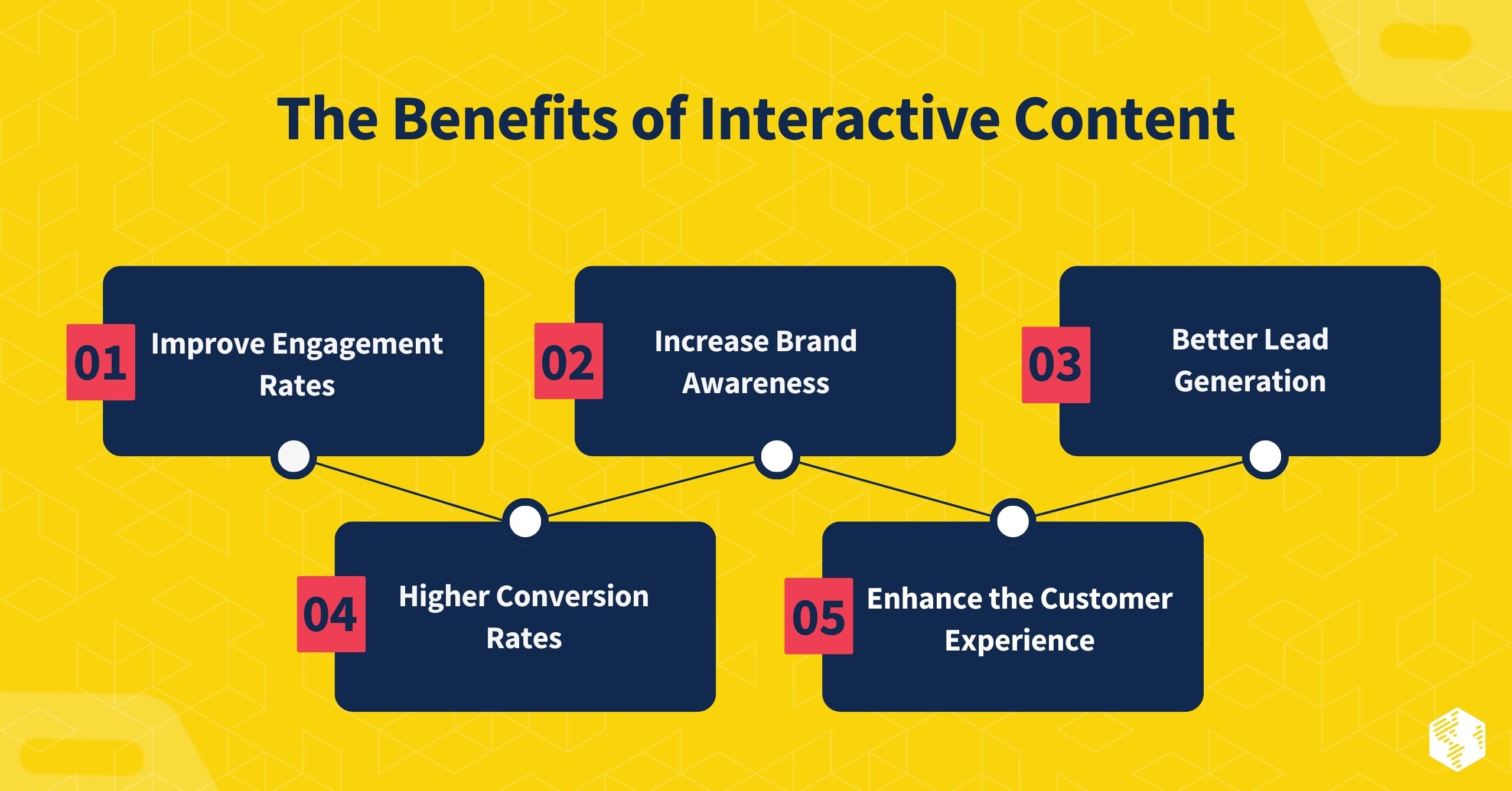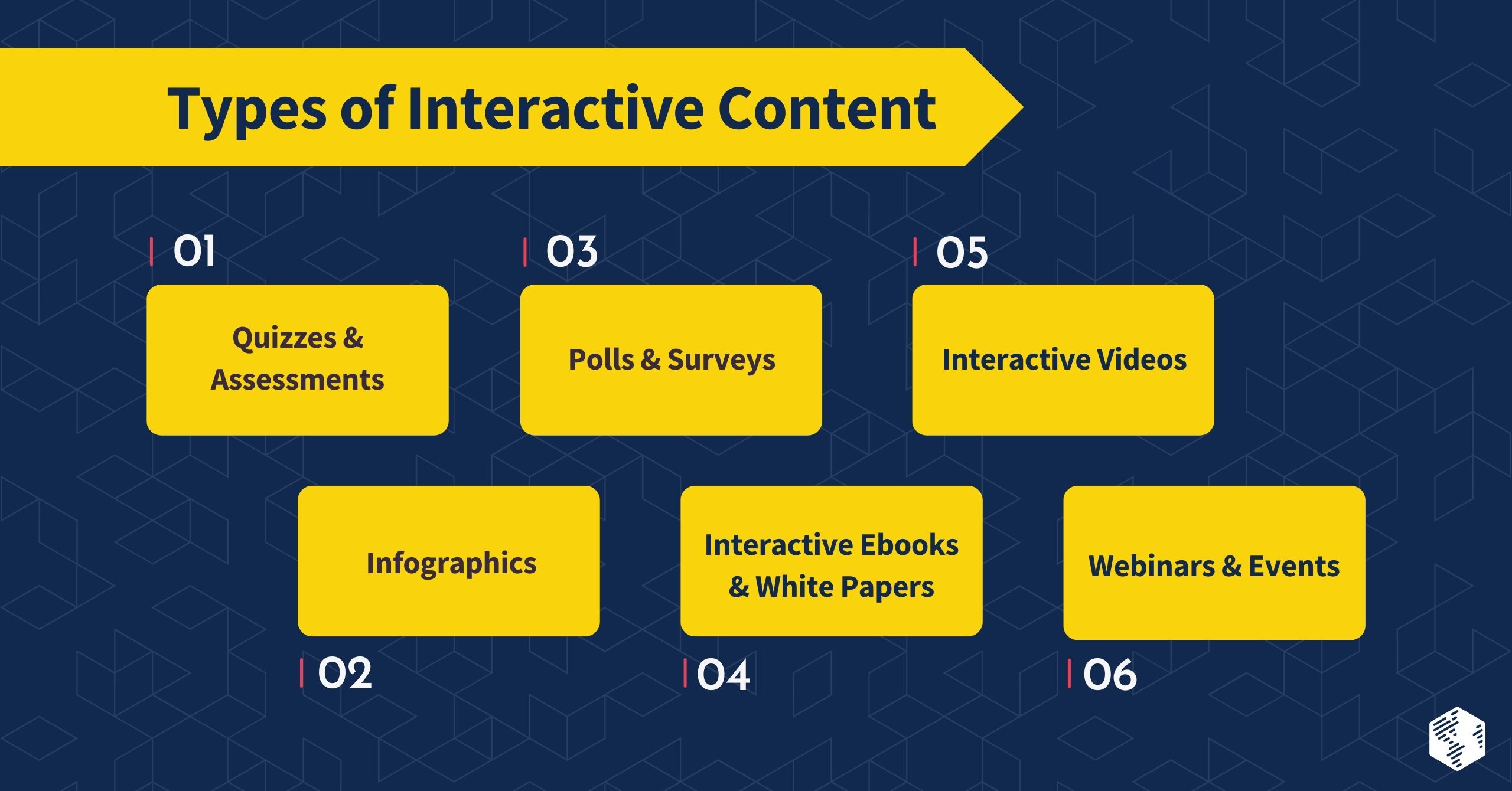When you hear the word “content,” what do you think of?
For decades, most of the content in content marketing has been things like ebooks, white papers, videos, blog posts, landing pages, and social posts. These content pieces are important, of course; high-quality, well-written content is an essential part of any successful marketing strategy. But today’s audiences want—and expect—more from their content.
They’re looking for content that is fun and interesting, grabs their attention, and invites them to participate in the conversation.
The time has come to step up your content marketing game with interactive content.
What Is Interactive Content Marketing?
Most content on the internet is static. The audience passively consumes it by reading or watching the content.
But interactive content is quickly gaining in popularity. When people encounter interactive content, they are encouraged to actively engage with it by clicking, answering questions, hovering, or sharing.
Interactivity can appear in many different types of content, from surveys and videos to ebooks and quizzes. It’s a two-way street because it creates a conversation that requires active participation from both sides (the creator and the user).
Interactive content marketing, then, is the use of interactive content—either instead of or in addition to traditional static content—in a content marketing strategy.
The Benefits of Interactive Content
More and more brands are testing out interactive content—and reaping the benefits.
If your company decides to invest in interactive content, you can expect to see several benefits, including improved engagement rates, brand awareness, lead generation, conversion rates, and customer experiences.
Improve Engagement Rates
By offering your audience interactive experiences instead of static content, you grab their attention more efficiently. They will also spend more time interacting with your content and brand. It all leads to improved engagement rates and deeper involvement with your brand.
Increase Brand Awareness
Interactive content is popular, shareable, and noteworthy. Audiences are more likely to pass along your content to their network on social media, giving your brand more visibility.
Additionally, thanks to the time they spend engaging with your content pieces, creating these branded interactive experiences for your audience helps them to develop into loyal customers.
Better Lead Generation
Content that is dynamic, engaging, interactive, and visually appealing provides a more interesting customer experience and offers real value to your audience. Users will be more likely to share their contact information with you since they get something in return—the interactive experience they are craving.
READ: Sales Lead Generation Tools to Supercharge Your Sales Pipeline
Higher Conversion Rates
You can customize your interactive content to meet the needs of your leads at every stage of the buyer’s journey, helping improve your lead nurturing efforts and leading to higher conversion rates.
Interactive content also provides deeper personalization options than static content. Instead of just including a potential customer’s first name in the greeting of an email (a tried-and-true personalization technique), imagine using the results of an interactive assessment to tailor product recommendations that solve their unique pain points—and then continuing to nurture the buyer until they’re ready to convert.
READ: The Secret to DOUBLING Your Conversion Rates (Growing Faster!)
Enhance the Customer Experience
Customers are looking for innovative, interesting, entertaining, and valuable experiences. In other words, they are looking for ways to interact with your brand.
While traditional static content adds value with information, interactive content adds an entertainment element alongside the informative piece. This content is more engaging, which means the user will have an enhanced customer experience.
Types of Interactive Content
Interactive content comes in a seemingly endless variety of formats and genres, all creating new ways to engage with users.
One thing to look out for is how the content interacts with its audience. Some types of interactive content are interactive by nature, like polls, surveys, and quizzes. Others are static contact that can become interactive, like videos, infographics, and ebooks.
Consider including several of these common types of interactive content in your marketing strategy.
Quizzes & Assessments
Quizzes are an incredibly popular type of interactive content. You may have seen them before, usually with creative, informal language that encourages people to have a little fun with it. They’re simple, effective ways to educate and entertain your audience, and they also capture valuable insights. If you encourage participants to share the results, they even have a chance of going viral.
Assessments are more thorough than quizzes. While taking an assessment, a user will answer several multiple-choice questions in exchange for information or insights on the topic matter. Not only are assessments a great way to get high-quality feedback, but they also encourage participants to continue through the sales funnel.
Polls & Surveys
Polls usually consist of one multiple-choice question, while surveys are more complex and usually contain many questions. Both are great methods for adding interactivity to your content. Use polls and surveys to get customer feedback, learn audience insights, or decipher market data.
It’s easier than ever to create a poll or survey. Most social media platforms, for example, have built-in poll features. All you have to do is enter the question, add the answer options, and post it.
Interactive Videos
Videos are already a highly engaging form of content. Audiences usually find them more interesting and dynamic than other types of text-based static content. However, you can take your videos to the next level by adding interactive elements.
Interactive videos may have quizzes, buttons, multiple narrative pathways, or clickable hotspots that take users to new webpages. And, with the rise of virtual reality (VR) and augmented reality (AR) technologies, you can create even more attractive, interactive videos for your customers.
Infographics
Infographics are an excellent way to visualize data and share important information with viewers. Adding points of interactivity throughout the material makes the infographic more attractive and effective. It’s also the key to making your content stand out in a sea of simple, static infographics.
Interactive buttons, quizzes, and pop-ups encourage people to participate in the content, gain a deeper understanding of the data, and share it with others.
Interactive Ebooks & White Papers
Ebooks and white papers are traditionally static content pieces, although white papers often include more technical content. Either way, they can be dry on their own. Making them interactive by adding images, graphics, videos, and animations to the texts means they will be much more interesting, enjoyable, and attractive to your audience.
Webinars & Events
The best webinars and events are interactive.
Share questions on live webinars, hold an interactive Q&A session, or collect topic suggestions from viewers. Anyone hosting an event or webinar can add interactive elements that create an unforgettable experience for attendees.
READ: Webinar Marketing in B2B: What Marketers Do Wrong and Why It Is Still Worth the Effort
Tips to Using Interactive Content in Your Digital Marketing Strategy
Are you ready to add interactive content to your current content calendar? Can you begin incorporating interactive elements into the existing content on your web pages?
Before you start playing around with interactive content, read these tips.
Know Your Audience
Your buyer personas should direct your interactive content marketing strategy.
Who is your audience? What are their pain points? How do they typically consume and interact with content? Where do they spend their time online?
The answers to these questions will help you determine what type of interactive content to offer—as well as where and when to offer it.
Repurpose Existing Content
Don’t let old content go to waste. Instead, give it a new life by adding interactive elements or repurposing existing content into interactive content pieces. Whether you add a product preference assessment to the bottom of a popular shopping page or turn an old blog post into an interactive infographic, you can reuse old content in a way that fits into your long-term strategy.
Create Interactive Content for Each Stage of the Buyer’s Journey
At each stage of the buyer’s journey, your audience has different needs, expectations, and desires. Create interactive content for the entire customer journey to improve your lead nurturing efforts and conversion rates.
An interactive infographic grabs attention from viewers and can be designed to help them understand and name their problem, which is perfect for the awareness stage of the buyer’s journey. Similarly, for the consideration stage, an educational, interactive ebook will help your audience determine the best way to solve their problem.
Consider how you can use interactive content to provide value at every stage.
MUST READ: A Guide to Understanding the Modern B2B Buyer’s Journey
Use a Responsive Layout
Everybody uses their phones to access digital content—including your potential customers. Your interactive content must be responsive on all screen types.
Since interactive content uses a lot of features that are tricky to incorporate into a responsive layout, like buttons and animations, you should test your content to ensure it provides users with a smooth content experience. The good news? Most interactive content tools automatically use a responsive layout, which makes it easier to publish accessible content.
Follow Your Brand Aesthetics
Following your brand aesthetics—from the color scheme and typography to the tone and voice—is essential for all types of content, including interactive content. When creating interactive, engaging content pieces, make sure it aligns with your brand aesthetics. It will help establish your brand identity and ensure you are cemented in the minds of your ideal customers.
If people enjoy your interactive content, they’re more likely to want to share it with the people in their network. Your job is to make sharing your content on social media as simple as possible.
Include social media sharing buttons on your interactive content, and encourage your audience to share the infographics, videos, and quizzes they find interesting. It’s a great way to boost your online visibility and get more leads.
Incorporate Different Types of Interactive Content into One Piece
Why stop at one type of interactive content? You can merge different kinds to create an engaging content piece.
For example, on the same page where you share an interactive infographic, add an assessment at the bottom to get more feedback from your audience. Or, a week after you send someone an interactive ebook, point them in the direction of a quiz they can take to see how well they understood the material.
Interactive Content Marketing Tools: Our 6 Favorites
With the content marketing tools available today, you can easily create interactive content pieces or add interactive elements to existing content. There are tools that specialize in certain types of interactive content (like quizzes or infographics) and others that serve as all-in-one interactive content platforms. Some even come with pre-designed templates that make it easier than ever to get started (with little to no coding or design experience required).
Here are a few of our favorites.
Ion Interactive
Ion Interactive is a comprehensive interactive content platform that makes it easy to create different types of interactive, responsive content. Using the provided templates, you can build interactive experiences for your audience, test out different materials to see which campaigns generate more conversions, and collect performance results.
Apester
Apester is an interactive content creation tool designed for those who have long-term content goals. Its create once, publish everywhere (COPE) approach to content makes it easy for you to not only build content but also repurpose it across multiple channels. The drag-and-drop editor and template library simplify the process so you can start reaching potential customers as soon as possible.
Typeform
Typeform is known across the internet as one of the best ways to create online forms, but you can also use this tool to build simple and responsive interactive forms, surveys, polls, quizzes, and more. With their template gallery, you can quickly create and embed interactive content on your website and collect information from anyone who interacts with it.
Ceros
Ceros is a simple, powerful platform for anyone who needs to create high-quality interactive content. Its drag-and-drop functionality means you don’t need to hire a developer or have any coding experience to add interactive elements to videos, infographics, or ebooks. You can use the tools on this platform to turn existing content into more dynamic, engaging pieces.
Involve.me
Involve.me is an interactive content builder that makes it easy to create surveys, quizzes, calculators, and other interactive elements—no coding experience required. Integrate it with your existing customer relationship management (CRM) and marketing tools to easily customize interactive content across your website.
Thinglink
Thinglink is designed to build many different types of interactive content that is responsive across all devices—videos, 360° media, maps, VR technology, infographics, and more. It also offers inbuilt analytics so you can easily measure the engagement rates of each interactive content piece.
Interactive Content: The Future of Content Marketing
Your audience is drowning in content.
New blogs, social posts, web pages, and emails are published every day—we’re talking about 650 million tweets and 333.2 billion emails a day and 70 million WordPress blog posts a month in 2022.
And there’s no sign that this cascade of new content will slow down anytime soon . . .
. . . which means that companies will have to try new ways to be more interesting, engaging, and unique so they can cut through the noise and reach their audience.
Experienced, digitally-savvy brands are already using interactive content to take things to the next level.
Customers are looking for innovative, intriguing, personalized experiences, so companies that invest time and resources into adding interactive elements to their content will stand out from the crowd. Expect to see more and more interactive content in the years to come.
Interactive content is the future, and the future starts now.
Ready to Incorporate Interactive Content into Your Marketing Strategy? We Can Help
Interactive content is the answer to creating memorable, valuable, and impactful marketing campaigns. If you want to drive results and set your brand apart from the competition, you need to start adding interactive elements to your content strategy. Whether you start by adding a few quizzes to your website, hosting an interactive webinar, or sharing polls on social media, that interaction is as good as gold.
And, if you’re looking for a partner to help incorporate interactive content into your digital marketing strategy, look no further.
At OneIMS, our content marketing experts are masters of interactive content. We have a long history of helping companies in a variety of industries innovate your marketing strategy, engage with your target audience, and build interactive content pieces that lead to higher conversion rates and deep brand loyalty.
We pride ourselves on using innovative and data-driven marketing solutions that produce measurable, sustainable results—but you don’t have to take our word for it. View testimonials from our clients and read our blog to get an idea of our training, experience, and track record of success.
Are you ready to add interactive content into your digital marketing strategy? Schedule a consultation with us today to get started.



































